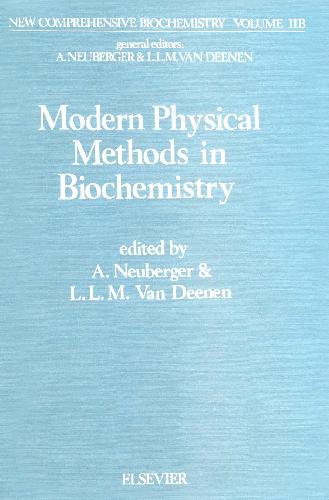Albert Neuberger,K Brocklehurst978-0-444-80968-1, 0-444-80968-6, 0-444-80303-3, 0-444-80649-0
Table of contents :
Modern Physical Methods in Biochemistry: Part B……Page 4
Preface……Page 6
Contents……Page 8
1. The Phenomenon of Fluorescence……Page 14
2. Factors Aaffecting the Fluorescence Emission……Page 17
3. Time-Resolved Fluorescence Spectroscopy……Page 26
4. Harmonic-Content Frequency-Domain Fluorometry……Page 36
Acknowledgements……Page 38
References……Page 39
1. Introduction……Page 40
2. The Units Used in Raman Sspectroscopy……Page 42
3. A Model for Raman Scattering Based on Classical Physics……Page 44
4. Raman and Resonance Raman Scattering: a Quantum Mechanical Interpretation……Page 47
5. Polarisation Properties of Raman Scattering……Page 50
6. Basic Experimental Aspects……Page 51
7. Raman Studies on Biological Materials……Page 53
References……Page 74
2. Continuous flow……Page 78
3. Stopped flow……Page 82
5. Temperature Jump……Page 89
6. Miscellaneous Methods……Page 90
7. Data Reduction……Page 91
References……Page 96
1. Introduction……Page 98
2. Techniques……Page 99
3. Applications……Page 109
4. Concluding remarks……Page 115
References……Page 116
1. Introduction……Page 120
2. Retention Relationships of Peptides in RP-HPLC……Page 124
3. The Relationship Between Peptide Retention Behaviour and Hydrophobicity Coefficients……Page 133
4. Bandwidth Relationships of Peptides in RP-HPLC……Page 139
5. Dynamic Models for Interconverting Systems……Page 144
Acknowledgements……Page 152
References……Page 153
1. Introduction……Page 156
2. Theory of X-ray and Eutron Scattering……Page 157
3. Experimental Practice and Instrumentation……Page 195
4. Applications of X-ray and Neutron Scattering……Page 207
5. Conclusions……Page 262
References……Page 264
1. Introduction……Page 280
2. Negative Staining and Metal Shadowing……Page 281
3. Thin Sectioning……Page 283
4. Low-Temperature Techniques……Page 285
References……Page 308
Subject Index……Page 314







Reviews
There are no reviews yet.